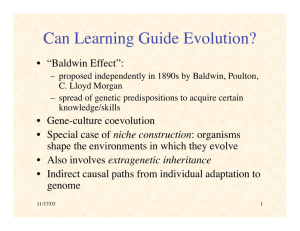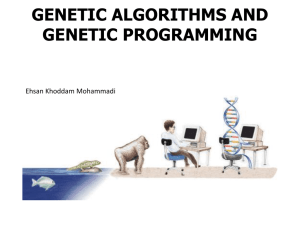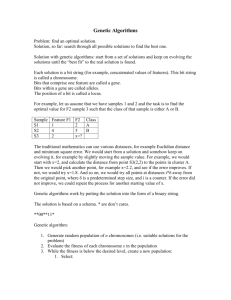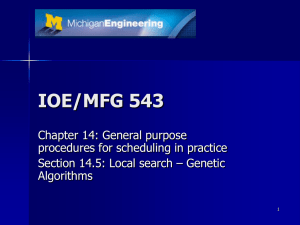Week 1-4 PPT
advertisement
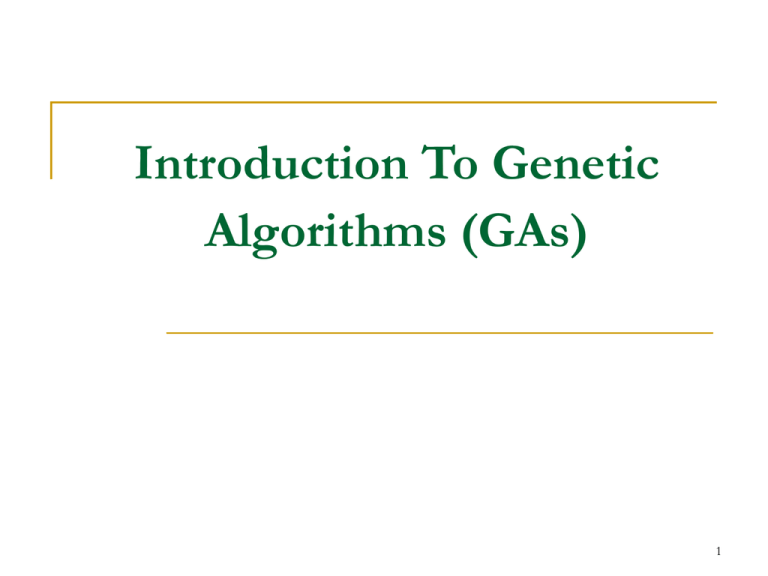
Introduction To Genetic
Algorithms (GAs)
1
History Of Genetic Algorithms
“Evolutionary Computing” was introduced in the 1960s
by I. Rechenberg.
John Holland wrote the first book on Genetic Algorithms
‘Adaptation in Natural and Artificial Systems’ in 1975.
In 1992 John Koza used genetic algorithm to evolve
programs to perform certain tasks. He called his method
“Genetic Programming”.
2
What Are Genetic Algorithms (GAs)?
Genetic Algorithms are search and
optimization techniques based on Darwin’s
Principle of Natural Selection.
3
Darwin’s Principle Of Natural Selection
IF there are organisms that reproduce, and
IF offspring's inherit traits from their ancestors, and
IF there is variability of traits, and
IF the environment cannot support all members of a
growing population,
THEN those members of the population with lessadaptive traits (determined by the environment) will die
out, and
THEN those members with more-adaptive traits
(determined by the environment) will thrive
The result is the evolution of species.
4
Basic Idea Of Principle Of Natural
Selection
“Select The Best, Discard The Rest”
5
An Example of Natural Selection
Giraffes have long necks.
Giraffes with slightly longer necks could feed on leaves of higher
branches when all lower ones had been eaten off.
They had a better chance of survival.
Favorable characteristic propagated through generations of
giraffes.
Now, evolved species has long necks.
NOTE: Longer necks may have been a deviant characteristic
(mutation) initially but since it was favorable, was propagated over
generations. Now an established trait.
So, some mutations are beneficial.
6
Evolution Through Natural Selection
Initial Population Of Animals
Struggle For Existence-Survival Of the Fittest
Surviving Individuals Reproduce, Propagate Favorable
Characteristics
Millions Of Years
Evolved Species
(Favorable Characteristic Now A Trait Of Species)
7
Start with a Dream…
Suppose you have a problem
You don’t know how to solve it
What can you do?
Can you use a computer to somehow find a
solution for you?
This would be nice! Can it be done?
8
A dumb solution
A “blind generate and test” algorithm:
Repeat
Generate a random possible solution
Test the solution and see how good it is
Until solution is good enough
9
Can we use this dumb idea?
Sometimes - yes:
if there are only a few possible solutions
and you have enough time
then such a method could be used
For most problems - no:
many possible solutions
with no time to try them all
so this method can not be used
10
A “less-dumb” idea (GA)
Generate a set of random solutions
Repeat
Test each solution in the set (rank them)
Remove some bad solutions from set
Duplicate some good solutions
make small changes to some of them
Until best solution is good enough
11
How do you encode a solution?
Obviously this depends on the problem!
GA’s often encode solutions as fixed length
“bitstrings” (e.g. 101110, 111111, 000101)
Each bit represents some aspect of the
proposed solution to the problem
For GA’s to work, we need to be able to
“test” any string and get a “score” indicating
how “good” that solution is
12
Silly Example - Drilling for Oil
Imagine you had to drill for oil somewhere
along a single 1km desert road
Problem: choose the best place on the road
that produces the most oil per day
We could represent each solution as a
position on the road
Say, a whole number between [0..1000]
13
Where to drill for oil?
Solution1 = 300
Solution2 = 900
Road
0
500
1000
14
Digging for Oil
The set of all possible solutions [0..1000] is
called the search space or state space
In this case it’s just one number but it could
be many numbers or symbols
Often GA’s code numbers in binary producing
a bitstring representing a solution
In our example we choose 10 bits which is
enough to represent 0..1000
15
Convert to binary string
512
256
128
64
32
16
8
4
2
1
900
1
1
1
0
0
0
0
1
0
0
300
0
1
0
0
1
0
1
1
0
0
In GA’s these encoded strings are sometimes called
“genotypes” or “chromosomes” and the individual bits are
sometimes called “genes”
16
Genetic Algorithms Implement
Optimization Strategies By Simulating
Evolution Of Species Through Natural
Selection.
17
Working Mechanism Of GAs
Begi
n
Initialize
population
Evaluate
Solutions
T =0
Optimum
Solution?
N
Selection
Y
T=T+1
Stop
Crossover
Mutation
18
Simple Genetic Algorithm
Simple_Genetic_Algorithm()
{
Initialize the Population;
Calculate Fitness Function;
While(Fitness Value != Optimal Value)
{
Selection;//Natural Selection, Survival Of Fittest
Crossover;//Reproduction, Propagate favorable
characteristics
Mutation;//Mutation
Calculate Fitness Function;
}
}
19
The GA Cycle of Reproduction
reproduction
children
modified
children
parents
population
deleted
members
discard
modification
evaluation
evaluated children
The GA Cycle of Reproduction
reproduction
children
modified
children
parents
population
deleted
members
discard
modification
evaluation
evaluated children
Nature to Computer Mapping
Nature
Population
Individual
Fitness
Chromosome
Gene
Reproduction
Computer
Set of solutions.
Solution to a problem.
Quality of a solution.
Encoding for a Solution.
Part of the encoding of a solution.
Crossover
22
GA Operators and
Parameters
23
Encoding
The process of representing the solution in the
form of a string that conveys the necessary
information.
Just as in a chromosome, each gene controls a
particular characteristic of the individual, similarly, each
bit in the string represents a characteristic of the
solution.
24
Encoding Methods
Binary Encoding – Most common method of
encoding. Chromosomes are strings of 1s and 0s and
each position in the chromosome represents a particular
characteristic of the problem.
Chromosome A
10110010110011100101
Chromosome B
11111110000000011111
25
Encoding Methods (contd.)
Permutation Encoding – Useful in ordering
problems such as the Traveling Salesman Problem
(TSP). Example. In TSP, every chromosome is a string of
numbers, each of which represents a city to be visited.
Chromosome A
1 5 3 2 6 4 7 9 8
Chromosome B
8 5 6 7 2 3 1 4 9
26
Encoding Methods (contd.)
Value Encoding – Used in problems where
complicated values, such as real numbers, are used and
where binary encoding would not suffice.
Good for some problems, but often necessary to develop
some specific crossover and mutation techniques for
these chromosomes.
Chromosome A
1.235 5.323 0.454 2.321 2.454
Chromosome B
(left), (back), (left), (right), (forward)
27
Fitness Function
A fitness function quantifies the optimality of a
solution (chromosome) so that that particular
solution may be ranked against all the other
solutions.
A fitness value is assigned to each solution depending
on how close it actually is to solving the problem.
Ideal fitness function correlates closely to goal + quickly
computable.
Example. In TSP, f(x) is sum of distances between the
cities in solution. The lesser the value, the fitter the
solution is.
28
Recombination
The process that determines which solutions are
to be preserved and allowed to reproduce and
which ones deserve to die out.
The primary objective of the recombination operator is to
emphasize the good solutions and eliminate the bad
solutions in a population, while keeping the population
size constant.
“Selects The Best, Discards The Rest”.
“Recombination” is different from “Reproduction”.
29
Recombination
Identify the good solutions in a population.
Make multiple copies of the good solutions.
Eliminate bad solutions from the population
so that multiple copies of good solutions
can be placed in the population.
30
Crossover
It is the process in which two chromosomes
(strings) combine their genetic material (bits) to
produce a new offspring which possesses both
their characteristics.
Two strings are picked from the mating pool at random to
cross over.
The method chosen depends on the Encoding Method.
31
Crossover Methods
Single Point Crossover- A random point is
chosen on the individual chromosomes (strings) and
the genetic material is exchanged at this point.
32
Crossover Methods (contd.)
Single Point Crossover
Chromosome1
11011 | 00100110110
Chromosome 2
11011 | 11000011110
Offspring 1
11011 | 11000011110
Offspring 2
11011 | 00100110110
33
Crossover Methods (contd.)
Two-Point Crossover- Two random points are
chosen on the individual chromosomes (strings) and
the genetic material is exchanged at these points.
Chromosome1
11011 | 00100 | 110110
Chromosome 2
10101 | 11000 | 011110
Offspring 1
10101 | 00100 | 011110
Offspring 2
11011 | 11000 | 110110
NOTE: These chromosomes are different from the last example.
34
Crossover Methods (contd.)
Uniform Crossover- Each gene (bit) is selected
randomly from one of the corresponding genes of the
parent chromosomes.
Chromosome1
11011 | 00100 | 110110
Chromosome 2
10101 | 11000 | 011110
Offspring
10111 | 00000 | 110110
NOTE: Uniform Crossover yields ONLY 1 offspring.
35
Crossover (contd.)
Crossover between 2 good solutions MAY NOT
ALWAYS yield a better or as good a solution.
Since parents are good, probability of the child
being good is high.
If offspring is not good (poor solution), it will be
removed in the next iteration during “Selection”.
36
Mutation
It is the process by which a string is deliberately
changed so as to maintain diversity in the
population set.
We saw in the giraffes’ example, that mutations could be
beneficial.
Mutation Probability- determines how often the
parts of a chromosome will be mutated.
37
Example Of Mutation
For chromosomes using Binary Encoding, randomly
selected bits are inverted.
Offspring
11011 00100 110110
Mutated Offspring
11010 00100 100110
NOTE: The number of bits to be inverted depends on the Mutation Probability.
38
Advantages Of GAs
Global Search Methods: GAs search for the
function optimum starting from a population of points of
the function domain, not a single one. This characteristic
suggests that GAs are global search methods. They can,
in fact, climb many peaks in parallel, reducing the
probability of finding local minima, which is one of the
drawbacks of traditional optimization methods.
39
Advantages of GAs (contd.)
Blind Search Methods: GAs only use the
information about the objective function. They do not
require knowledge of the first derivative or any other
auxiliary information, allowing a number of problems to
be solved without the need to formulate restrictive
assumptions. For this reason, GAs are often called blind
search methods.
40
Advantages of GAs (contd.)
GAs use probabilistic transition rules during
iterations, unlike the traditional methods that use fixed
transition rules.
This makes them more robust and applicable to a large
range of problems.
41
Advantages of GAs (contd.)
GAs can be easily used in parallel machinesSince in real-world design optimization problems, most
computational time is spent in evaluating a solution, with
multiple processors all solutions in a population can be
evaluated in a distributed manner. This reduces the
overall computational time substantially.
42
Some GA Application Types
Domain
Application Types
Control
gas pipeline, pole balancing, missile evasion, pursuit
Design
Scheduling
semiconductor layout, aircraft design, keyboard
configuration, communication networks
manufacturing, facility scheduling, resource allocation
Robotics
trajectory planning
Machine Learning
Signal Processing
designing neural networks, improving classification
algorithms, classifier systems
filter design
Game Playing
poker, checkers, prisoner’s dilemma
Combinatorial
Optimization
set covering, travelling salesman, routing, bin packing,
graph colouring and partitioning
Genetic Algorithms To Solve
The Traveling Salesman
Problem (TSP)
45
A Salesman wishes to travel around a given set of cities,
and return to the beginning, covering the smallest total
distance
Easy to State
Difficult to Solve
46
A 42-City Problem The Nearest Neighbour Method
(Starting at City 1)
5
8
25
37
31
24
41
26
14
28
6
36
32
30
27
11
15
7
23
9
33
40
22
29
12
13
2
19
34
42
35
20
16
38
17
4
21
3
1
18
10
39
47
The Nearest Neighbour Method (Starting at City 1)
5
8
25
37
31
24
41
26
14
28
6
36
32
30
27
11
15
7
23
9
33
40
22
29
12
13
2
19
34
42
35
20
16
38
17
4
21
3
1
18
10
39
48
The Nearest Neighbour Method (Starting at City 1)
Length 1498
5
8
25
37
31
24
41
26
14
28
6
36
32
30
27
11
15
7
23
9
33
40
22
29
12
13
2
19
34
42
35
20
16
38
17
4
21
3
1
18
10
39
49
Remove Crossovers
5
8
25
37
31
24
41
6
26
14
28
32
36
30
27
11
7
15
23
33
40
22
9
29
12
13
19
2
34
35
42
20
16
17
38
4
21
3
1
18
10
39
50
Remove Crossovers
5
8
25
37
31
24
41
6
26
14
28
32
36
30
27
11
7
15
23
33
40
22
9
29
12
13
19
2
34
35
42
20
16
17
38
4
21
3
1
18
10
39
51
Remove Crossovers
Length 1453
5
8
25
37
31
24
41
6
26
14
28
32
36
30
27
11
7
15
23
33
40
22
9
29
12
13
19
2
34
35
42
20
16
17
38
4
21
3
1
18
10
39
52
Length 1189
5
8
25
37
31
24
41
28
6
26
32
30
27
14
36
11
15
7
23
33
40
22
9
29
12
13
2
19
34
42
35
20
16
38
17
4
21
3
1
18
10
39
53
Length 1192
5
8
25
37
31
24
41
6
26
14
28
32
36
30
27
11
15
7
23
9
33
40
22
29
12
13
2
19
34
42
35
20
16
38
17
4
21
3
1
18
10
39
54
Length 1193
5
8
25
37
31
24
41
28
6
26
32
30
27
14
36
11
7
15
23
33
40
22
9
29
12
13
2
19
34
42
35
20
16
38
17
4
21
3
1
18
10
39
55
Length 1194
Optimal Solution
5
8
25
37
31
24
41
6
26
14
28
32
36
30
27
11
7
15
23
33
40
22
9
29
12
13
2
19
34
42
20
16
3
35
17
4
21
1
18
38
10
39
56
The Problem
The Traveling Salesman Problem is defined
as:
‘We are given a set of cities and a symmetric distance
matrix that indicates the cost of travel from each city to
every other city.
The goal is to find the shortest circular tour, visiting
every city exactly once, so as to minimize the total
travel cost, which includes the cost of traveling from the
last city back to the first city’.
Traveling Salesman Problem
57
Encoding
I represent every city with an integer .
Consider 6 cities –
Riyadh, Dammam , Majmah, Jeddah , Qassim and
Abha and assign a number to each.
Riyadh
Dammam
Majmah
Jeddah
Qassim
Abha
1
2
3
4
5
6
58
Encoding (contd.)
Thus a path would be represented as a sequence of
integers from 1 to 6.
The path [1 2 3 4 5 6 ] represents a path from Riyadh to
Dammam, Dammam to Majmah, Majmah to Jeddah,
Jeddah to Qassim, Qassim to Abha, and finally from
Abha to Riyadh.
This is an example of Permutation Encoding as the
position of the elements determines the fitness of the
solution.
59
Fitness Function
The fitness function will be the total cost of the tour
represented by each chromosome.
This can be calculated as the sum of the distances
traversed in each travel segment.
The Lesser The Sum, The Fitter The Solution
Represented By That Chromosome.
60
Distance/Cost Matrix For TSP
1
2
3
4
5
6
1
0
863
1987
1407
998
1369
2
863
0
1124
1012
1049
1083
3
1987
1124
0
1461
1881
1676
4
1407
1012
1461
0
2061
2095
5
998
1049
1881
2061
0
331
6
1369
1083
1676
2095
331
0
Cost matrix for six city example.
Distances in Kilometers
61
Fitness Function (contd.)
So, for a chromosome [4 1 3 2 5 6], the total cost of
travel or fitness will be calculated as shown below
Fitness = 1407 + 1987 + 1124 + 1049 + 331+ 2095
= 7993 kms.
Since our objective is to Minimize the distance, the
lesser the total distance, the fitter the solution.
62
Selection Operator
I used Tournament Selection.
As the name suggests tournaments are played between
two solutions and the better solution is chosen and
placed in the mating pool.
Two other solutions are picked again and another slot in
the mating pool is filled up with the better solution.
63
Tournament Selection (contd.)
Mating Pool
7993
4 1 3 2 5 6
6872
4 3 2 1 5 6
6872
4 3 2 1 5 6
8673
5 2 6 4 3 1
8971
3 6 4 1 2 5
8673
5 2 6 4 3 1
8971
3 6 4 1 2 5
7993
4 1 3 2 5 6
7993
4 1 3 2 5 6
8479
8142
2 6 3 4 5 1
8479
8142
2 6 3 4 5 1
6872
4 3 2 1 5 6
6 3 4 5 2 1
6872
4 3 2 1 5 6
6 3 4 5 2 1
8142
2 6 3 4 5 1
8673
5 2 6 4 3 1
8142
2 6 3 4 5 1
64
Why we cannot use single-point
crossover:
Single point crossover method randomly selects a
crossover point in the string and swaps the substrings.
This may produce some invalid offsprings as shown
below.
4 1 3 2 5 6
4 1 3 1 5 6
4 3 2 1 5 6
4 3 2 2 5 6
65
Mutation Operator
The mutation operator induces a change in the solution,
so as to maintain diversity in the population and prevent
Premature Convergence.
In our project, we mutate the string by randomly
selecting any two cities and interchanging their positions
in the solution, thus giving rise to a new tour.
4
1
3
2
5
6
4
5
3
2
1
6
66
Major Practical Extension of the TSP
Vehicle Routing - Meet customers demands within given
time windows using lorries of limited capacity
10am-1pm
7am-8am
3am-5am
4pm-7pm
6pm-7pm
Depot
8am-10am
6am-9am
2pm-3pm
Much more difficult than TSP
67
Real-Life Applications
The solution of several important “real world” problems is the
same as finding a tour of a large number of cities
Transportation: school bus routes,
service calls, delivering meals, …
Manufacturing: an industrial robot
that drills holes in printed circuit
boards
VLSI (microchip) layout
Communication:
telecommunication networks`
For many of these problems n
(the number of “cities”) can be
1,000 or more
planning
new
Summary
69
Genetic Algorithms (GAs) implement optimization
strategies based on simulation of the natural law of
evolution of a species by natural selection
The basic GA Operators are:
Encoding
Recombination
Crossover
Mutation
GAs have been applied to a variety of function
optimization problems, and have been shown to be
highly effective in searching a large, poorly defined
search space even in the presence of difficulties such as
high-dimensionality, multi-modality, discontinuity and
noise.
70
Questions ?
71

